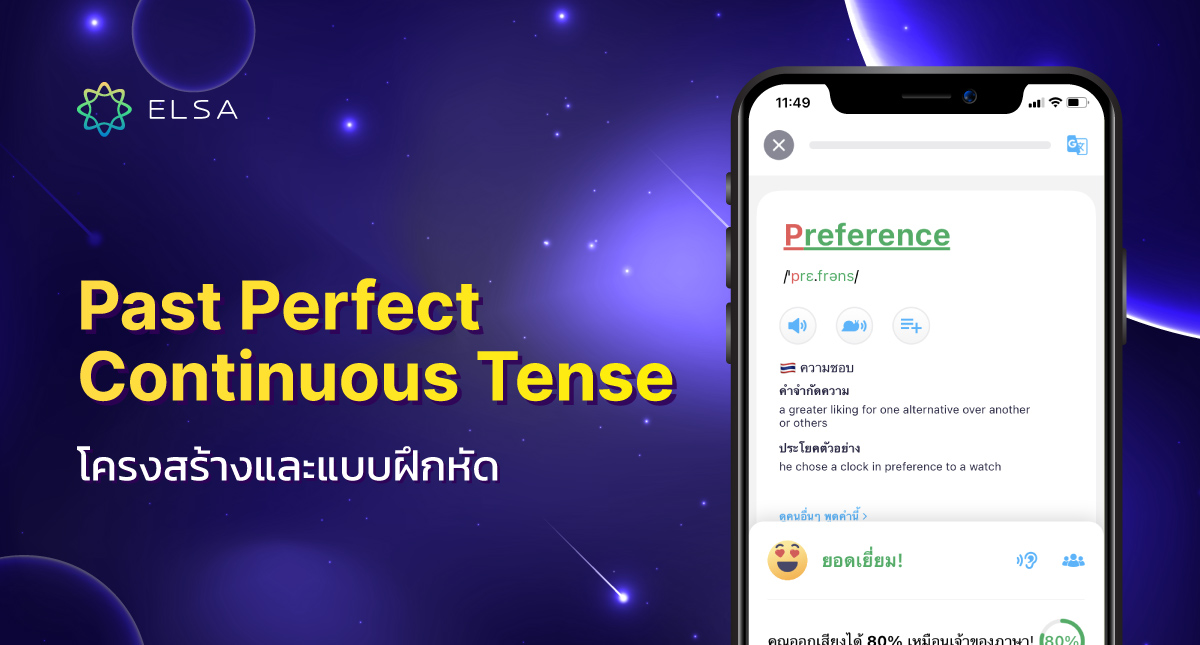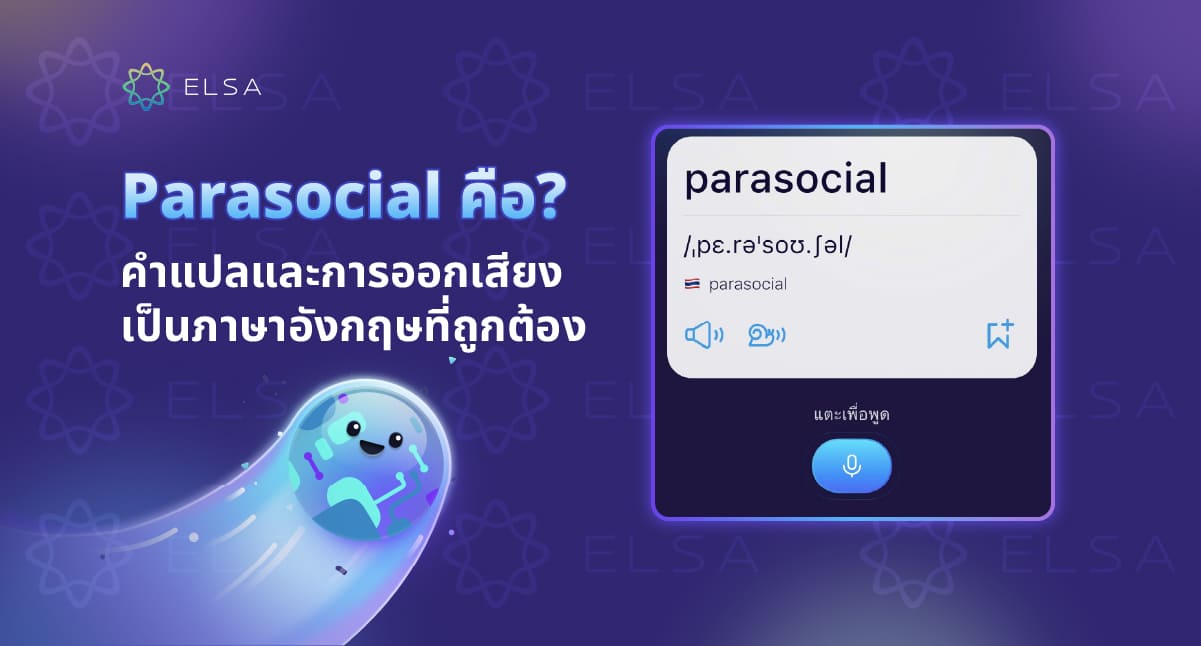Past Perfect Continuous Tense เป็นหนึ่งใน tense พื้นฐานในภาษาอังกฤษที่คุณต้องเชี่ยวชาญ บทความต่อไปนี้ ELSA Speak จะเผยความรู้ทั้งหมดเกี่ยวกับ Past Perfect Continuous Tense รวมถึง คำนิยาม โครงสร้าง หลักการใช้งาน และแบบฝึกหัดบางส่วน เพื่อช่วยให้คุณคุ้นเคยกับ tense นี้ มาลองดูตอนนี้เลย!
Past Perfect Continuous คืออะไร
Past Perfect Continuous เป็น tense ที่แสดงการกระทำหรือเหตุการณ์ที่เกิดขึ้นก่อนการกระทำอื่นในอดีต และเน้นความต่อเนื่องของการกระทำนั้น
สอบก่อนเข้าฟรี

Past Perfect Continuous Tense ตัวอย่างประโยค:
I had been working very hard until they came to help me.
(ฉัน (เคย) ทำงานหนักมากจนพวกเขามาช่วยฉัน)
It had been raining for hours before it finally stopped at 4 this afternoon.
(ฝนตกนานหลายชั่วโมงก่อนจะหยุดตกตอน 4 โมงเย็นในวันนี้)
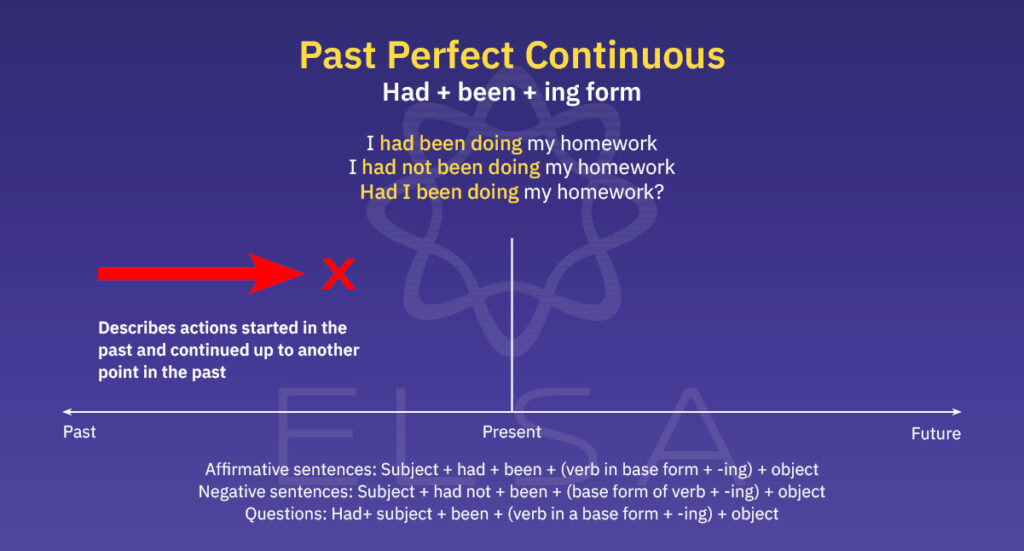
โครงสร้าง Past Perfect Continuous Tense
รูปแบบประโยคบอกเล่า
| S + had + been + V-ing + … |
ตัวอย่าง
They had been dancing non-stop when came.
(พวกเขาเต้นไม่หยุดเมื่อเรามาถึง)
She had been practicing for hours so she was exhausted when we saw her.
(เธอฝึกมาหลายชั่วโมง (ก่อนหน้านี้) ดังนั้นเธอจึงหมดแรงเมื่อเราเห็นเธอ)
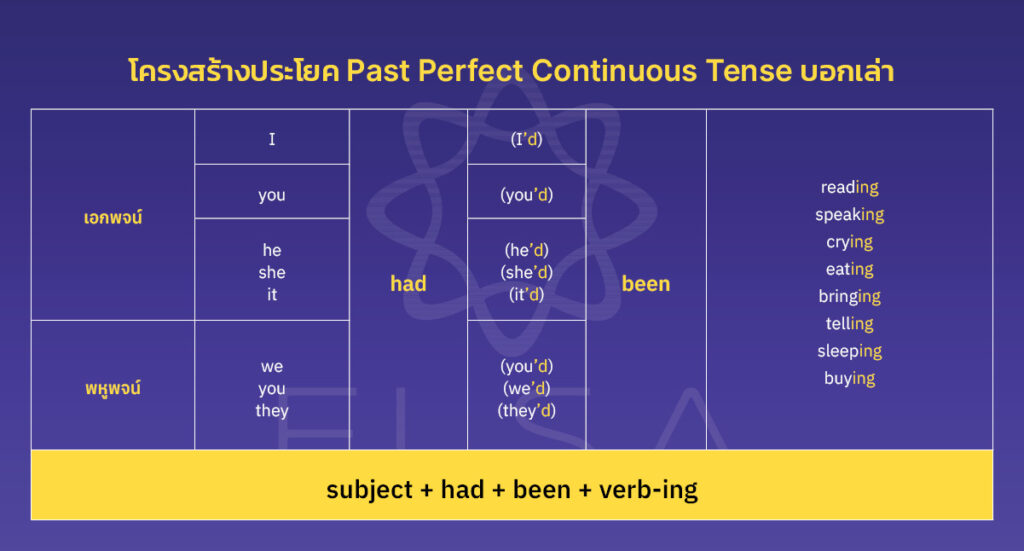
รูปแบบประโยคปฏิเสธ
| S + had not (hadn’t) + been + V-ing + … |
ตัวอย่าง
That hadn’t been living in that house for years before we bought it last year.
(พวกเขาไม่ได้อาศัยอยู่ในบ้านหลังนั้นมาหลายปีก่อนที่เราจะซื้อมันเมื่อปีที่แล้ว)
Marie and I hadn’t been talking until she called me last night.
(มารีกับฉันไม่ได้คุยกัน (เป็นเวลาหนึ่ง) จนกระทั่งเธอโทรหาฉันเมื่อคืนนี้)
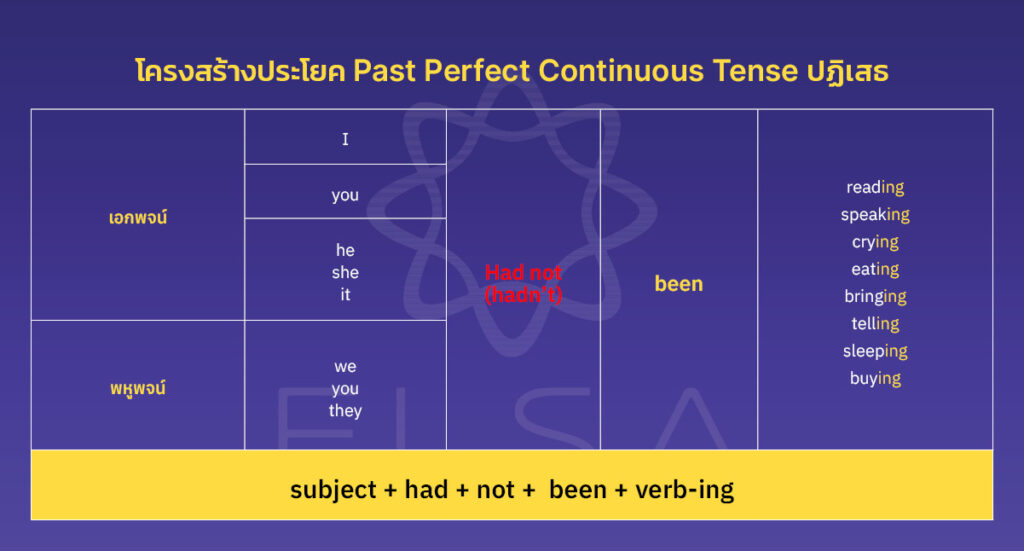
รูปแบบประโยคคำถาม
คำถาม Yes – No
| Had + S + been + V-ing + …? |
| Yes, S + had.No, S + hadn’t. |
ตัวอย่าง
Had our daughter been doing her homework before you got home?
(ลูกสาวของเราทำการบ้านก่อนที่คุณจะกลับถึงบ้านหรือเปล่า)
➥ Yes, she had.
Had you been cooking for hours when they came to help?
(คุณทำอาหารเป็นชั่วโมงเมื่อพวกเขามาช่วยหรอ)
➥ No, I hadn’t.
(ไม่นะ)
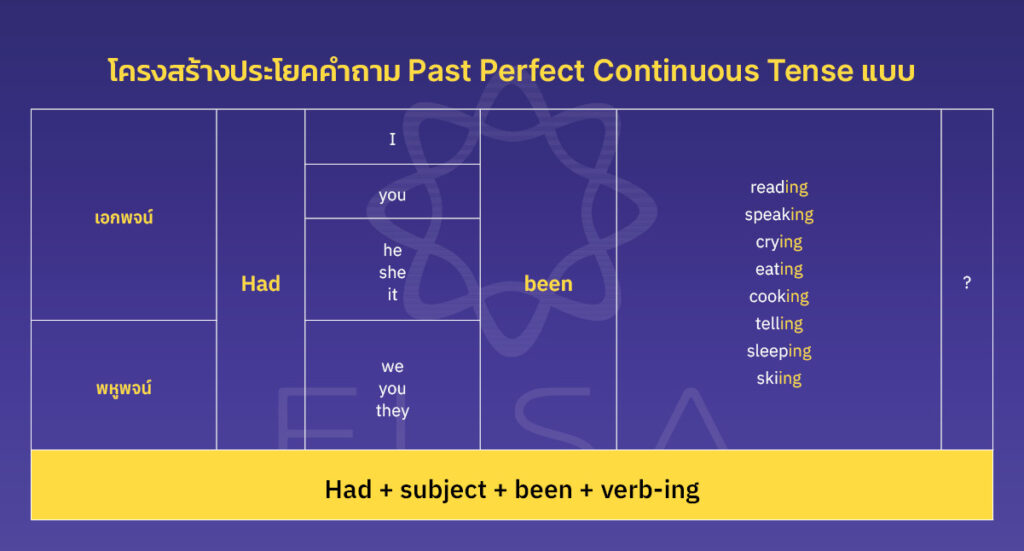
คำถาม Wh-
คำใช้ถามที่ไม่ใช่หัวเรื่อง
What/ Where/ When/ Why/ How/ Who(m) + had + (not) + S + been + V-ing + … ?
ตัวอย่าง
What had our son been doing in the attic when you came in?
(ลูกชายของเราทำอะไรในห้องใต้หลังคาเมื่อคุณเข้ามา)
Where had he been hiding before the bad guy found him
(เขาซ่อนตัวอยู่ที่ไหนก่อนที่คนร้ายจะเจอเขา)
Who(m) had she been talking to until I called her?
(เธอคุยกับใครจนกระทั่งฉันโทรหาเธอ)
คำใช้ถามคือหัวเรื่อง
What/ Who + had (not) + V3/ed + …? (be)
ตัวอย่าง
What had been bothering you before you talked to the doctor yesterday?
(มีอะไรรบกวนคุณก่อนที่คุณจะคุยกับหมอเมื่อวานนี้)
Who had been living in this room for nearly 10 years before I moved in?
(ใครอาศัยอยู่ที่นี่เกือบ 10 ปีก่อนที่ฉันย้ายเข้ามา)
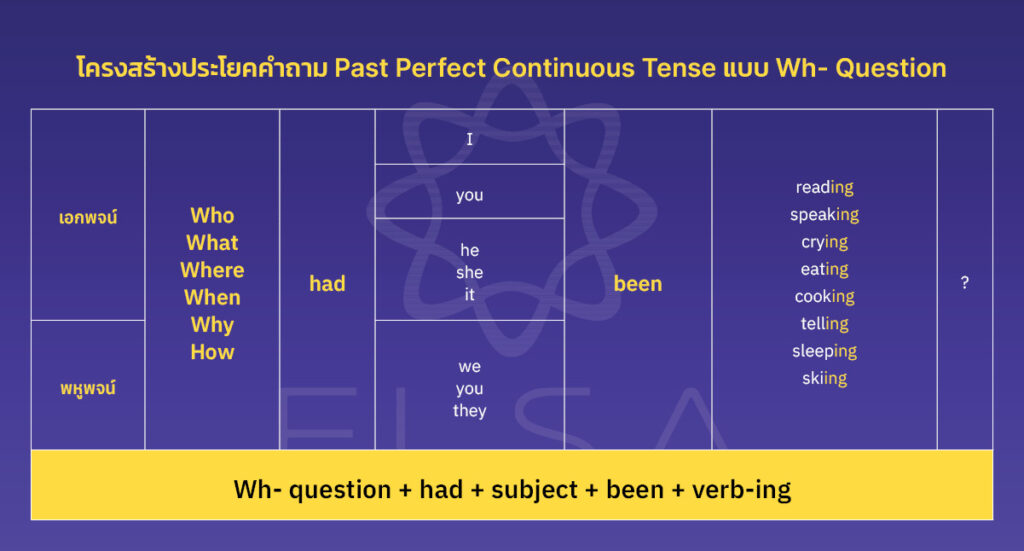
วิธีการผันคำกริยาใน Past Perfect Continuous Tense
คำกริยาใน Past Perfect Continuous Tense ค่อนข้างยาว โดยมีส่วนประกอบ 3 ส่วนดังนี้: had + been + V-ing
โดยที่ ‘had’ และ ‘been’ ไม่ได้เปลี่ยนแปลง แต่ ‘V-ing’ จะเปลี่ยนไปตามกริยาในแต่ละกรณี
หมายเหตุ: เนื่องจาก Past Perfect Continuous Tense ก็เป็น Continuous Tense จึงจะมีคำกริยาบางคำที่เราไม่ค่อยได้ใช้ใน tense นี้ เช่น
คำกริยาแสดงอารมณ์ ชอบ เกลียด ความต้องการ…
- like: ชอบ
- love: รัก
- dislike: ไม่ชอบ
- hate: เกลียด
- want: อยาก
- prefer: ชอบมากกว่า (การเลือก)
- need: ต้องการ
คำกริยาแสดงความคิด ความเห็น…
- think: คิด
- believe: เชื่อใน
- know: รู้ว่า
- understand: เข้าใจ
- remember: จำบางสิ่งในอดีต/จำสิ่งที่ต้องทำ
- forget: ลืมบางสิ่งในอดีต/ลืมทำบางสิ่ง
- realize: ตระหนักว่า
หมายเหตุ: เมื่อคำกริยา ‘think’ หมายถึง “คิดถึงใครบางคน/บางสิ่ง” และตามด้วย ‘of/ about’ + คำนาม เราก็สามารถใช้ ‘think’ ใน Past Perfect Continuous Tense

คำกริยาเชื่อมโยง (linking verbs) และเกี่ยวข้องกับการรับรู้ทางประสาทสัมผัส
- taste: รส
- smell: เหม็น
- feel: รู้สึก (This place feels cozy. – สถานที่นี้ให้ความรู้สึกอบอุ่น)
- sound: ฟังดูเหมือน
- seem: ดูเหมือน
- look: ดูเหมือนว่า
หมายเหตุ: เมื่อคำกริยาข้างต้นไม่ได้ทำหน้าที่เชื่อมโยง และไม่แสดงการรับรู้ทางประสาทสัมผัส แต่ทำหน้าที่ของคำกริยาการกระทำและแสดงการกระทำ เราสามารถใช้คำนั้นได้ใน Past Perfect Continuous Tense เมื่อมีความหมายต่อไปนี้:
- taste: เพื่อลิ้มรส
- smell: กลิ่น
- feel: รู้สึกอย่างไร
- sound: เพื่อสร้างเสียง/ทำให้เกิดเสียง
- look at something: ดูบางอย่าง
คำกริยาเชื่อม ‘be’
‘be’ ไม่ค่อยได้ใช้ใน Continuous Tense คุณต้องหลีกเลี่ยงการแปลโดยตรงจากภาษาไทยเป็นภาษาอังกฤษเพื่อไม่ให้เกิดข้อผิดพลาดในการใช้ ‘be’ ใน Continuous Tense เมื่อไม่จำเป็นหรือไม่ควรใช้
ตัวอย่าง
คุณมีประโยคภาษาไทยในหัวอยู่แล้วว่า “เธอเคยเศร้าและกำลังเศร้าก่อนที่เขาจะมา”
จากนั้นพยายามแปลเป็นภาษาอังกฤษว่า “She HAD BEEN BEING sad before he came.”
ในขณะที่วิธีพูดที่ถูกต้องตามหลักไวยากรณ์และเป็นธรรมชาติที่สุดก็คือ “She HAD BEEN sad before he came.”
ดังนั้นแทนที่จะคิดเป็นภาษาไทยแล้วแปลเป็นภาษาอังกฤษ คุณเพียงแค่พิจารณาจากแนวคิดที่คุณต้องการพูด จากนั้นเลือกโครงสร้างและคำศัพท์ภาษาอังกฤษที่เหมาะสมเพื่อแสดงแนวคิดนั้น
อย่างไรก็ตาม ยังมีบางกรณีที่ผู้พูดใช้ ‘be’ ใน Present Continuous Tense เพื่อเน้นเรื่องชั่วคราว เรื่องนี้จะกล่าวถึงในบทความอื่นเกี่ยวกับคำกริยาที่ไม่ได้ใช้ใน Continuous Tense
หลักการเติม -ing
หมายเหตุ:
- คำกริยา ‘like’, ‘love’, ‘dislike’ และ ‘hate’ ยังสามารถนำมาใช้ใน Past Perfect Continuous Tense เมื่อผู้พูดต้องการเน้นความชั่วคราวของอารมณ์ แต่ว่ากรณีนี้ไม่เป็นที่นิยม
- หากคำกริยาที่จะผันไม่ได้อยู่ในสถานการณ์ด้านล่างนี้ ให้เติม -ing ต่อกริยาตามปกติ
>>> Read more: Irregular Verbs –กริยาไม่ปกติในภาษาอังกฤษที่ครบถ้วนที่สุด
คำกริยาที่ลงท้ายด้วย “e”
เมื่อคำกริยาที่จะผันลงท้ายด้วย “e” เราต้องทิ้ง “e” แล้วเติม -ing
ตัวอย่าง
- They are racing. (race → racing)
(พวกเขากำลังแข่ง)
- Look! She’s waving at us. (wave → waving)
(ดูสิ! เธอกำลังโบกมือให้พวกเรา)
คำกริยาที่ลงท้ายด้วย “ie”
ในกรณีนี้ เราต้องเปลี่ยน “ie” เป็น “y” แล้วเติม -ing
ตัวอย่าง
- Her cat is lying in my bed. (lie → lying)
(แมวของเธอกำลังนอนอยู่บนเตียงของฉัน)
- There’s too much to do. I’m dying. (die → dying)
(มีมากเกินไปที่จะทำ ฉันกำลังจะตาย)
คำกริยาที่มี 1 พยางค์ ลงท้ายด้วยพยัญชนะ นำหน้าด้วยสระ
ในกรณีนี้ เราเพิ่มพยัญชนะตัวสุดท้ายเป็นสองเท่า แล้วเติม -ing
ตัวอย่าง
- The hairdresser is cutting my hair. (cut → cutting)
(ช่างตัดผมกำลังตัดผม)
- They are putting fruits into the fridge. (put → putting)
(พวกเขากำลังใส่ผลไม้เข้าไปในตู้เย็น)
คำกริยาที่มี 2 พยางค์ ลงท้ายด้วยพยัญชนะ นำหน้าด้วยสระ เน้นเสียงอยู่ที่พยางค์ที่ 2
ในกรณีนี้ เรายังเพิ่มพยัญชนะตัวสุดท้ายเป็นสองเท่า แล้วเติม -ing
ตัวอย่าง
Leaves are beginning to fall. (begin→ beginning; /bɪˈɡɪn/)
(ใบไม้กำลังเริ่มร่วงหล่น)
| มาทบทวนกริยาไม่ปกติทั้ง 600 คำ (irregular verbs) และเรียนรู้เพิ่มเติมเกี่ยวกับการใช้งานใน Past Perfect Continuous Tense รวมถึงโครงสร้างอื่น ๆ ของ irregular verbs กัน |
หลักการใช้ Past Perfect Continuous Tense
Past Perfect Continuous Tense มี 2 หน้าที่ และหน้าที่หลักก็ได้กล่าวถึงในส่วนที่ 1 แล้ว
สองหน้าที่ของ Past Perfect Continuous Tense คือ
| แสดงการกระทำที่เริ่มต้นก่อนช่วงเวลาหนึ่งหรือการกระทำอื่นในอดีต และดำเนินต่อไปจนถึงช่วงเวลานั้นหรือการกระทำนั้น |
- She had been working for that company for 10 years before she quit her job there.
(เธอทำงานให้กับบริษัทนั้นเป็นเวลา 10 ปีก่อนที่เธอจะลาออกจากที่นั่น)
→ วิเคราะห์: การ “ทำงานให้กับบริษัทนั้น” เริ่มขึ้น ดำเนินไป และสิ้นสุดในเวลาที่ “เธอลาออก”
→ หมายเหตุ: ในกรณีนี้ เราสามารถใช้ Past Perfect Tense ได้ แต่จะไม่เน้นระยะเวลายาวนานของการกระทำ “ทำงานให้กับบริษัทนั้นเป็นเวลา 10 ปี”
- No one had been using that machine when we bought it.
(ไม่มีใครใช้เครื่องนั้นเมื่อเราซื้อมัน)
→ วิเคราะห์: การ “ไม่มีใครใช้เครื่องนั้น” เริ่มขึ้น ดำเนินไป และสิ้นสุดในเวลาที่ “เราซื้อมัน”
→ หมายเหตุ: ในกรณีนี้ เราสามารถใช้ Past Perfect Tense ได้ แต่จะไม่เน้นระยะเวลายาวนานของการกระทำ “ไม่มีใครใช้เครื่องนั้น”
| แสดงและเน้นการกระทำที่เกิดขึ้นและสิ้นสุด แต่ยังส่งผลในเวลาต่อมาในอดีต |
- It had been raining and the ground was still wet this afternoon.
(ฝนตกและพื้นดินยังเปียกในบ่ายวันนี้)
→ วิเคราะห์: “ฝนตก” เกิดขึ้นและสิ้นสุดก่อนเวลา “บ่ายวันนี้” แต่ผลยังปรากฏอยู่ในเวลานั้น คือ “พื้นดินยังเปียกอยู่”
- She had been singing all yesterday evening, and her throat was sore this morning.
(เธอร้องเพลงตลอดเย็นวานนี้ และเช้านี้เธอเจ็บคอ)
→ วิเคราะห์: “เธอร้องเพลง” เกิดขึ้นและสิ้นสุดก่อนเวลา “เช้านี้” ก็คือ “เย็นวานนี้” แต่ผลยังปรากฏอยู่ในเวลา “เช้านี้”: “เธอเจ็บคอ”
สัญญาณการรับรู้ Past Perfect Continuous Tense
กรณีที่ 1
Past Perfect Continuous Tense ใช้ในประโยคความเดียวพร้อมวลีระบุช่วงเวลาในอดีตที่มีโครงสร้าง: before/ until/ by/… + noun (phrase)
ตัวอย่าง
- They hadn’t been talking to each other until yesterday.
(พวกเขาไม่ได้คุยกันจนถึงเมื่อวาน)
- Marie and I had been living together before our graduation last year.
(ฉันกับมารีอยู่ด้วยกันก่อนเรียนจบปีที่แล้ว)
กรณีที่ 2
Past Perfect Continuous Tense สามารถใช้ในอนุประโยคของประโยคที่ซับซ้อนได้
อนุประโยคที่เหลือใช้ Simple Past Tense และเริ่มต้นด้วย when/ before/ until/ by the time/…
หรืออนุประโยคหนึ่งใช้ Simple Past Tense และอีกอนุประโยคหนึ่งใช้Past Perfect Continuous Tense แล้วเริ่มต้นด้วย ‘After’
ตัวอย่าง
- They hadn’t been talking to each other until they met yesterday.
(พวกเขาไม่ได้คุยกันจนกระทั่งพบกันเมื่อวานนี้)
- Marie and I had been living together by the time we graduated last year.
(มารีกับฉันอยู่ด้วยกัน (ตลอด) ก่อนที่เราจะเรียนจบเมื่อปีที่แล้ว)
ตัวอย่างประโยค Past Perfect Continuous Tense
Our daughter had been studying by 11:30 last night.
(ลูกสาวของเราเรียนจนถึงห้าทุ่มครึ่งเมื่อคืนนี้)
We had been living together before that argument.
(เราอยู่ด้วยกันก่อนที่จะทะเลาะกัน)
My best friend had been working as a tutor until her graduation last month.
(เพื่อนสนิทของฉันทำงานเป็นครูสอนพิเศษจนกระทั่งเธอสำเร็จการศึกษาเมื่อเดือนที่แล้ว)
Our parents had been using that company’s products for years before their scandal last week.
(พ่อแม่ของเราใช้ผลิตภัณฑ์ของบริษัทนั้นมาหลายปีก่อนที่จะเกิดเรื่องอื้อฉาวเมื่อสัปดาห์ที่แล้ว)
Last night, our son had been watching a Netflix series until 11:45.
(เมื่อคืนลูกชายของเราดูซีรีส์ Netflix จนถึง 11:45 น)
She had been studying non-stop by the time she took a break at 3pm.
(เธอเรียนไม่หยุดจนกระทั่ง (ก่อน) เลิกเรียนเวลาบ่าย 3)
That employee had been writing that report the whole morning before she moved on to a new one.
(พนักงานเขียนรายงานนั้นตลอดทั้งเช้าก่อนจะไปรายงานฉบับอื่น)
The students had been practicing before they performed yesterday.
(นักเรียนฝึก (ตลอด) ก่อนทำการแสดงเมื่อวานนี้)
She had been working overtime for weeks, and she was still exhausted yesterday.
(เธอทำงานล่วงเวลามาหลายสัปดาห์แล้ว และเมื่อวานเธอก็ยังเหนื่อยอยู่)
The kids had been playing games too much, and this morning, their eyes were still tired.
(เด็กๆ เล่นเกมส์กันเยอะ (เป็นเวลาหนึ่ง) และเช้านี้ตายังล้าอยู่เลย)
ความแตกต่างระหว่าง Past Perfect Tense กับ Past Perfect Continuous Tense
เหมือนกัน:
พูดคุยเกี่ยวกับการกระทำเกิดขึ้นก่อนเวลาหรือการกระทำอื่นในอดีต
ความแตกต่าง
- ข้อที่ 1
| Past Perfect Continuous Tense | Past Perfect Tense |
|---|---|
| แสดงและเน้นระยะเวลายาวนานของการ กระทำ | ใช้สำหรับการกระทำที่เกิดขึ้นในระยะเวลาสั้น ๆ ไม่ใช่ยาวนานในช่วงเวลาหนึ่งที่แน่นอน หรือใช้เมื่อไม่อยากเน้นถึงความยาวนานดังกล่าว |
| ตัวอย่าง She had been studying for hours before she took a break at 3pm. (เธอเรียนหลายชั่วโมงก่อนจะพักตอนบ่าย 3) → เน้นว่า การเรียนรู้นี้ใช้เวลายาวนานระยะหนึ่ง ก็คือ “หลายชั่วโมง” ก่อนการ “พัก” ที่จะเกิดขึ้น | ตัวอย่าง She had studied before she took a break at 3pm. (เธอเรียนก่อนจะพักตอนบ่าย 3) → เพียงแสดงว่า ก่อน “พักตอนบ่าย 3” เธอก็ “เรียน” |
| *หมายเหตุ ถ้าในประโยคกล่าวถึงระยะเวลาที่การกระทำเกิดขึ้นก่อนมีความยาวนาน เช่น ‘for hours/ years/ a long time/…’ และการกระทำที่เกิดขึ้นก่อนคือการกระทำที่สามารถมีความยาวนาน (‘live’, ‘sleep’, ‘study’, …) → ใช้ Past Perfect Continuous Tense | *หมายเหตุ ถ้าในประโยค (มักจะ) ไม่ได้กล่าวถึงระยะเวลานานของการกระทำเกิดขึ้นก่อน เช่น ‘for hours/ years/ a long time/…’ และการกระทำที่เกิดขึ้นก่อนคือการกระทำที่ไม่สามารถเกิดนานได้ (‘begin’, ‘start’, ‘stop’, …) → ใช้ Past Perfect Tense อย่างไรก็ตาม จะมีบางกรณีที่จะสามารถใช้ Past Perfect Continuous Tense ได้ แต่ผู้พูด/ผู้เขียนไม่ต้องการเน้นระยะเวลายาวนาน จึงใช้เฉพาะ Past Perfect Tense เท่านั้น |
- ข้อที่ 2
| Past Perfect Continuous Tense | Past Perfect Tense |
|---|---|
| แสดงและเน้นการกระทำที่เกิดขึ้นและสิ้นสุด แต่ยังส่งผลในเวลาต่อมาในอดีต | ในด้านไวยากรณ์ ยังใช้ได้ แต่ไม่ได้ผลในการเน้นย้ำได้เท่ากับ Past Perfect Continuous Tense เพราะตามการรับรู้ของเจ้าของภาษาส่วนใหญ่ การใช้ Past Perfect Continuous Tense สามารถเน้นย้ำสถานการณ์ดังกล่าวได้จริงๆ |
| ตัวอย่าง It had been raining and the ground was still wet this afternoon. → ฝนตกและพื้นดินยังเปียกในบ่ายวันนี้ |
| การเข้าใจ Past Perfect Continuous Tense ช่วยให้คุณอธิบายประสบการณ์การทำงานที่เกิดขึ้นต่อเนื่องในอดีตได้ชัดเจนยิ่งขึ้น เมื่อนำไปใช้ใน cv ภาษาอังกฤษ ก็จะช่วยเล่าเส้นทางการทำงานของคุณได้เป็นลำดับและดูเป็นมืออาชีพมากขึ้น |
แบบฝึกหัดเกี่ยวกับ Past Perfect Continuous Tense
แบบฝึกหัดที่ 1: ผันคำกริยาในวงเล็บเป็นกริยาใน Past Perfect Continuous Tense ให้ถูกต้อง
1. We__________________ (live) there before we moved to District 12.
2. Before the contest, they__________________ (practice) for days.
3. After she__________________ (work) for hours, her eyes were tired.
4. Before we took her to hospital, she__________________ (not eat) anything for 2 days.
5. We__________________ (clean) the house for hours when our parents said that we should stop.
6. Before the meeting, they__________________ (not take) care of the customers well.
7. My mom__________________ (use) that phone for years before it was stolen last week.
คำตอบ:
1. had been living
2. had been practiced
3. had been working
4. hadn’t been eating
5. had been cleaning
6. hadn’t been taking
7. had been using
แบบฝึกหัดที่ 2: จัดเรียงคำด้านล่างเพื่อสร้างประโยคที่ถูกต้อง
1. for years/ they/ they/ before/ bought a house/ had been living in that flat/.
2. for hours/ I started using that computer/ my sister/ , / when/ had been working on it/.
3. until/ had been doing homework/ 3am today/ our daughter/.
4. /gave him a day off/ he/ our boss/ had been working overtime for days/ after.
5. had been working part-time as a sales assistant/ before/ she/ her first full-time job/.
คำตอบ:
1. They had been living in that flat for years before they bought a house.
2. When I started using that computer, my sister had been working on it for hours.
3. Our daughter had been doing homework until 3am today.
4. After he had been working overtime for days, our boss gave him a day off.
5. She had been working part-time as a sales assistant before her first full-time job.
แบบฝึกหัดที่ 3: แต่ละประโยคด้านล่างมีข้อผิดพลาด 1 ข้อ จงค้นหาและแก้ไขให้ถูกต้อง
1. They have been singing for hours by the time we came.
2. My parents had lived there for nearly 7 years before they moved to another city.
3. By the time we saw him lying on the floor, he has been working non-stop.
4. After she had sung for hours last night, her throat was still sore this afternoon.
5. My sister had been working as a sales assistant after she became a model.
คำตอบ:
1. have been singing → had been singing
2. had lived → had been living (การใช้ Past Perfect Tense ก็ไม่ผิดหลักไวยากรณ์ แต่จะไม่เน้นความยาวนานและความต่อเนื่องของการกระทำ ‘live’)
3. have been singing → had been singing
4. had sung → had been singing (การใช้ Past Perfect Tense ก็ไม่ผิดหลักไวยากรณ์ แต่จะไม่เน้นความยาวนานและความต่อเนื่องของการกระทำ ‘sung’)
5. after → before
แบบฝึกหัดที่ 4: ผันคำกริยาในวงเล็บลงใน Past Perfect Continuous Tense หรือ Past Perfect Tense ให้ถูกต้อง
1. She__________________ (play) the piano for nearly 3 hours when you came.
2. Before your arrival, they__________________ (end) the meeting.
3. That family__________________ (move) to another place before you bought the house.
4. The concert__________________ (start) before we arrived.
5. That team__________________ (practice) for hours so when we came, the members were all exhausted.
คำตอบ:
1. had been playing (เน้นความยาวนานของการกระทำ)
2. had ended (การกระทำ ‘end’ ไม่สามารถดำเนินต่อไปได้อีก)
3. had moved (การกระทำ ‘move’ ไม่สามารถดำเนินต่อไปได้อีก)
4. had started (การกระทำ ‘start’ ไม่สามารถดำเนินต่อไปได้อีก)
5. had been practicing (เน้นความยาวนานของการกระทำ)
แบบฝึกหัดที่ 5: ผันคำกริยาในวงเล็บลงใน Past Perfect Continuous Tense หรือ Simple Past Tense ให้ถูกต้อง
1. That singer had been performing for nearly an hour when we __________________ (arrive).
2. She__________________ (use) the computer for a long time and it still__________________ (feel) hot when I touched it a few minutes ago.
3. That family__________________ (sing) karaoke for hours before we__________________ (ask) them to stop.
4. Before I__________________ (turn) it off, that video__________________ (play) for hours.
5. When she__________________ (get) to the company, we__________________ (discuss) the new project for nearly 2 hours.
คำตอบ:
1. arrived
2. had been using- felt
3. had been singing- asked
4. turned- had been playing
5. got- had been discussing
แบบฝึกหัดที่ 6: จับคู่แต่ละข้อในคอลัมน์ A กับข้อที่เหมาะสมในคอลัมน์ B
| A | B |
|---|---|
| 1. It had been raining heavily, | A. she was still tired and sleepy this afternoon. |
| 2. When we saw them at the supermarket, | B. when we told her stop. |
| 3. By the time we got to the party, | C. they had been shopping there since 1pm. |
| 4. After our daughter had been playing games the whole evening yesterday, | D. and some parts of the city were still flooded this afternoon. |
| 5. Our daughter had been studying for hours | E. they had been drinking and eating for quite a long time. |
คำตอบ:
| 1. D | 2. C | 3. E | 4. A | 5. B |
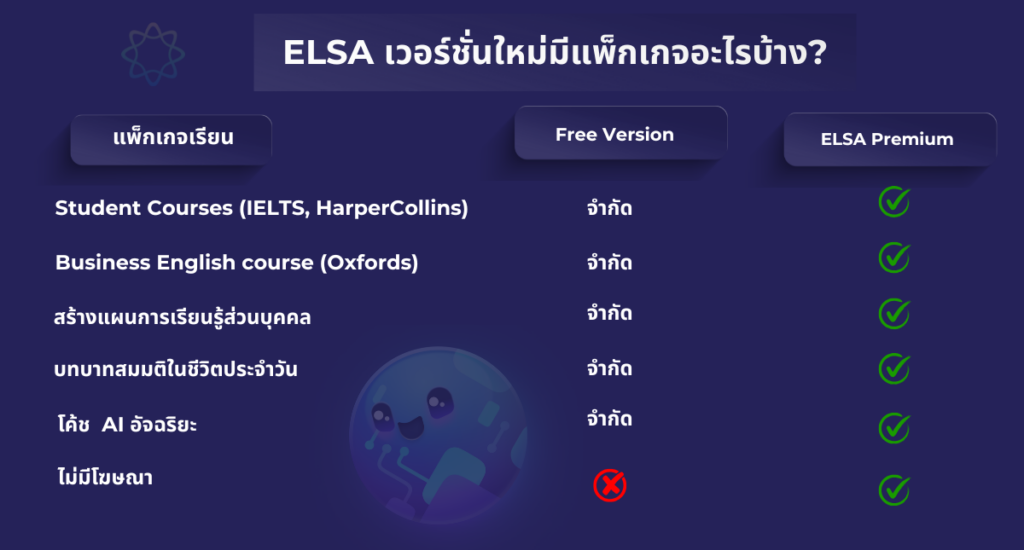
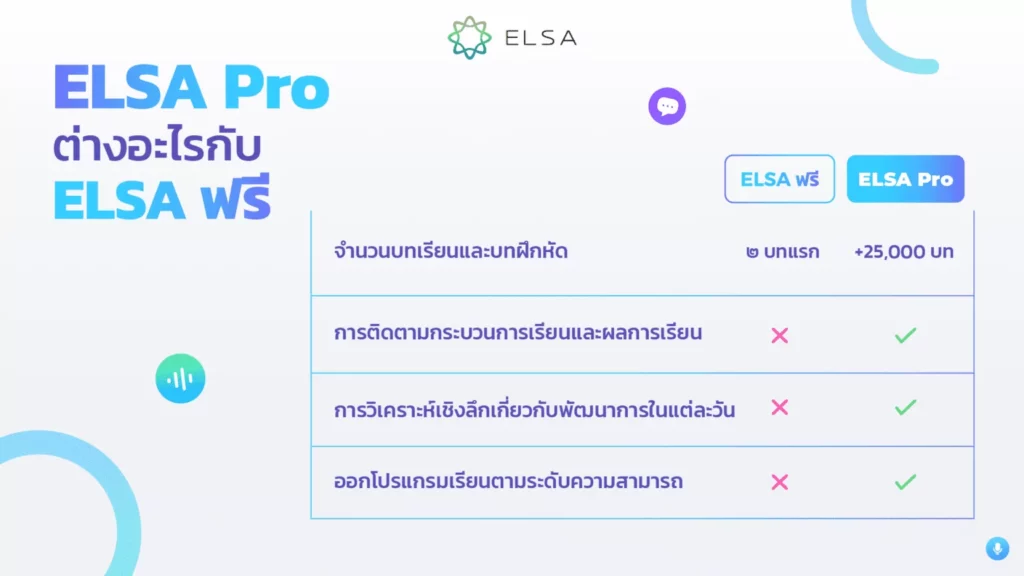
แบบฝึกหัดที่ 7: เขียนอีกหนึ่งอนุประโยคเข้าที่หลังอนุประโยคด้านล่างเพื่อแสดงผล/อิทธิพล
1. Yesterday, when I got home,…
2. By the time I had lunch yesterday,…
3. … before I left work today.
4. … by lunch yesterday.
5. … before last weekend.
คำตอบ:
คำตอบเหล่านี้เป็นคำตอบปลายเปิด ซึ่งขึ้นอยู่กับความคิดของคุณเอง ดังนั้นคำตอบด้านล่างมีไว้สำหรับอ้างอิงเท่านั้น และเพื่อให้คุณเห็นวิธีใช้ Past Perfect Continuous Tense
1. Yesterday, when I got home, my father had been cooking dinner.
2. By the time I had lunch yesterday, I had been working very hard.
3. I had been writing an important report before I left work today.
4. My family had been spending time together by lunch yesterday.
5. I had been working overtime for days before last weekend.
